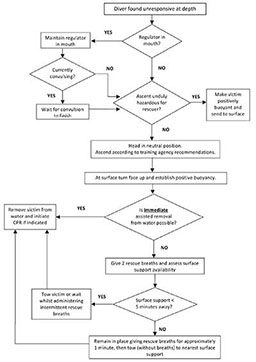Dive accidents are rare events, but they do happen. When divers become unconscious underwater, they face an incredibly high risk of injury or death. In these situations, the victim’s fellow divers must draw on their strength, training and intelligence to bring about the best possible conclusion to the emergency. Rescues of unconscious divers are very complicated events, and even perfect, by-the-book rescue attempts by the most well-trained people frequently result in poor outcomes.
There are many reasons why a diver might lose consciousness underwater. It may result from a lack of oxygen (hypoxia), a medical emergency such as a heart attack, an excess of carbon dioxide (hypercapnia) or an excess of oxygen (oxygen toxicity). One thing these situations have in common is the need to get the diver out of the water and into the hands of qualified medical professionals as quickly as possible.
Background
In 2007 the Undersea and Hyperbaric Medical Society (UHMS) Diving Committee was asked to review the practices being taught for in-water resuscitation. Our committee, chaired by Dr. Simon Mitchell, is comprised of an international team of experts in diving and hyperbaric medicine.
The now defunct YMCA Scuba Program had requested guidance following new recommendations that appeared in the 2005 American Heart Association’s Emergency Cardiac Care standards, which emphasized compressions during cardiopulmonary resuscitation (CPR). Confusion was arising during courses and training drills about the administration of ventilations (rescue breaths) while on the surface with a victim. The scope of this review was expanded at the request of the scientific diving community as well as committee member Jarrod Jablonski of the Global Underwater Explorers (GUE) training agency. Jablonski requested a more detailed review that included consideration of oxygen toxicity events.
Methods
The review was drafted primarily by Drs. Simon Mitchell and Michael Bennett. The reviewers first identified the questions to be addressed and then conducted an exhaustive literature review to identify the best possible evidence to support the committee’s conclusions. In situations where supporting literature or case histories were not available, committee consensus was reported.
Our team used the Professional Association of Diving Instructors (PADI) Rescue Diver Manual as a starting point for the expected behavior of a rescue diver assisting a victim. Rescues were analyzed and reviewed in three phases: 1. preparation for ascent to the surface, 2. retrieval of the victim to the surface, and 3. procedures for the care of the victim at the surface. Special considerations for victims found with a rebreather were reviewed for each of these phases.
Summary
The submerged-diver-rescue decision tree is a graphical representation of the various points the committee addressed. In the initial phase, the discussion focused on what to do if the regulator or rebreather mouthpiece had come out of the diver’s mouth and, if it was still in place, whether the diver was experiencing a convulsion. For the ascent phase it was noted that the best ascent rate for the victim may be “as fast as possible,” but that might conflict with what is safe for the rescuer. In some cases, the rescuer might have a decompression obligation, and a direct ascent could place him or her at considerable risk. In such cases it might be necessary to make the victim positively buoyant and send him unassisted to the surface. Once the victim is on the surface and positively buoyant, the rescuer must then promptly assess the need for rescue breaths and quick egress from the water.

The application of this decision tree depends on the rescuer having the appropriate foundational knowledge and experience of formal diver-rescue training. (It is never too late to learn new skills or practice old ones.)
It is completely appropriate for rescuers to ensure their own safety when using these recommendations. The degree of risk you are willing to assume to help another is something only you can determine. Keep in mind that a safety stop is only a recommendation following a no-decompression dive and should not be considered a decompression obligation.
The committee doubts the recent changes to CPR instruction are relevant to submerged-diver rescue. In a dive accident that includes respiratory arrest, there could be a variable period of time in which rescue breaths may prevent the accident from progressing to cardiac arrest. This is because the respiratory arrest in a dive accident is likely due to a lack of oxygen (asphyxia).
Our committee appreciates that there are circumstances that aren’t adequately accounted for in these guidelines; the intention is to provide guidance that is not overly complicated. These should not be considered immutable rules for all situations.
Impact
This intensive, evidence-based review of diver-rescue procedures has already begun to have an impact on the diving community. The GUE training standards have been amended to include guidance provided by this effort.
Reference
Mitchell, Simon J; Bennett, Michael H; Bird, Nick; Doolette, David J; Hobbs, Gene W; Kay, Edward; Moon, Richard E; Neuman, Tom S; Vann, Richard D; Walker, Richard; Wyatt, H Alan (2012). “Recommendations for rescue of a submerged unresponsive compressed-gas diver.” Undersea and Hyperbaric Medicine 39 (6): 1099–1108. http://archive.rubicon-foundation.org/10161
© Alert Diver — Q4 Fall 2013